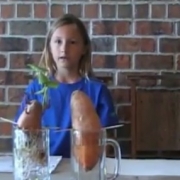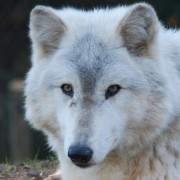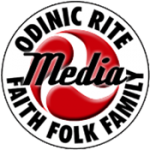Heimdall, Mother Jorth, and Unlikely Suburban Foods.
By Jim AOR
First published in ORB 210, Autumn 2008
Heimgest recently pointed out in “Increased Hearing through Silence” that Heimdall, god of humankind and civilization, is able to hear even lamb’s wool and grass grow. This kind of ability is an example of his patience and his sensitivity to the processes of biological life. Our ancestors realized how important such patience and sensitivity were. The processes by which they gathered, grew and harvested food were not those of the modern consumer. Our age of fast food and grocery store convenience has over time divorced many of our folk from the ability to emulate the patience and sensitivity of Heimdall. In turn, we have distanced ourselves from this father of human kind, as well as Mother Jorth.
This late industrial age, and the Lokian entities that maintain it, seek to send us into a whirlwind. Not only are we subject to the rat race of globalized capital, in which certain national and ethnic allegiances are more distasteful than ever, but we are also subject to the shallow distractions these same entities offer us. Many treat intimate contact with Mother Jorth as novel and unnecessary. In the case of my own family, it took one generation assimilated with Loki’s institutions to remove much of the knowledge of my own elders. There are many elements outside the hearth and home that threaten to remove us even further from knowledge of Mother Jorth’s works.
It is therefore important for us to emulate Heimdall as much as possible. We can work with Mother Jorth as one way of doing this. Learn about a plant, particularly a plant that has some human use, but don’t simply identify it and move on. Sit with this living organism and be with it. This can be an activity that is very meditative. Realize you are not by yourself. You are in front of a conscious being and are surrounded by other conscious beings.
Being with a plant, I believe, is not a New Age or “hippy” concept. Our ancestors recognized the consciousness of various plants. For example, a brief look at charms transcribed during the middle ages (such as the Merseburg charm) can give one an idea of herbs’ importance as conscious organisms, and as offspring of our indigenous deities. Furthermore, from the standpoint of the physical sciences, your interaction with a plant benefits the plant and you.
Because edible plants were important to our ancestors, and will again become important to us, I seek to learn about the edible plants of my own Odal lands here in North Carolina. Getting to know particular plants, watching them grow, learning their uses at different times of the year, and allowing Mother Jorth to bear them in Her time while being conscious of that life process, can lead to sensitivity and patience lost for many caught up in the age of convenience and consumerism that surrounds us.
I for one don’t want to entertain regrets and excuses. Although I miss the rural area where I grew up and the nature-bound wisdom of my now-deceased grandparents, developing relationships with edible (and usually wild) plants is a way I can increase my connection to Mother Jorth even in my current suburban environment. I believe the same holds true for others in suburban and even urban settings.
In the suburbs of south eastern Vinland, there are many plants that the uninformed take as virtually useless. Here are some plants I have made use of:
Dandelion- this plant is often treated as a useless pest today, but it has many uses that were known to our folk. Most -if not all -readers will recognize this plant, with its sharp and irregularly lobed leaves, as well as its young yellow flowers, which eventually turn into downy white seed balls that are easy to blow off into the wind. Dry, roast, and powder the root for a coffee substitute. Boil and ferment the roots to make a sherry-like wine. Boil the roots and drink as a tea. Eat the young flowers for food. My favorite use for this plant, however, is to eat the young leaves (younger leaves seem to have less bite). They make a good addition to salads and sandwiches.
Day Lily- here is a plant often used for purely decorative purposes, with its colorful yellow or orange flowers. The stalks from which the flowers bloom are leafless, but long, swordlike, light green leaves shoot up around them. Apparently the shoots (ie “new-borns”) of this plant are edible, but I have experience with more mature plants, since they were already present on my current property when I moved here. I find the flower buds and petals, particularly of the more substantial orange variety, have a vegetable-like substance and flavor. Note, however, there are wild varieties that are also edible.
Pine- it’s such a common tree, but many are unaware of its uses. Every reader probably knows how to identify the pine. Its needle like leaves and seed cones are its most recognizable features. They tend to grow easily in large numbers in both Vinland and Europe. The tender young shoots can be stripped of their green needles, peeled, boiled, and then steeped in syrup for use as a candy. The needles of younger or older trees can also be chopped and boiled for use as a tea. Just make sure they’re green! It seemed to me and a friend of mine that this tea had a lemony flavor.
Rose- There is already a great article concerning the rose on the OR Guardians website. I strongly recommend the plant connoisseur read it. Commercially planted roses are perhaps not as tasty as wild roses, but they are edible nonetheless. This may be a good addition to your salad, but they can also be good when “candied” (gently coated with egg white, sprinkled with fine sugar, and dried).
Sorrel- Smaller varieties have been frequently mistaken for a four-leaf clover (or at least a clover) because their leaves resemble it so closely. The variety most accessible to me is of the smaller kind and bears with it little yellow flowers. This common growth can be a good garnish to a salad, and has been used especially by Appalachian folk as a lemonade-like drink. Many discourage excessive use of sorrel. This is because it contains oxalic acid, which is harmful when used in large amounts… but so are many other things.
Sweet Goldenrod- This can be used as a tea rather than a food. Its toothless leaves and clusters of small yellow flowers can be boiled dried or fresh into a tea that benefits the kidneys. I have run into this “weed” all over North Carolina, including the area in which I live now. The crushed leaves tend to produce an anise-like aroma.
Wild Onion- this plant has a long stem with a cluster of tiny flowers on top that are often stringy and sprout in all directions. You may also find the cluster before it blossoms, which itself can look like a cluster of tiny onion-like formations (given you are looking at the right variety). Another treasure that is treated as a pesky weed, wild onion makes a tasty treat. My father and I used to pick these. Pull the bulbs of this plant from the ground, peel, and eat as they are, or add to a more complex dish as you would shallots. Some wild onions, like the ones near my house, even taste like garlic.
Some things to be wary of: make sure no one puts herbicides or other chemical mixtures on the lawns where you are looking. Stay away from main roads because plants growing at their edges may have absorbed many unhealthy pollutants. Additionally, this article should not be your only source for these plants. Learn them well from other references. Gather all the information you can from legitimate internet sites, printed literature, and wise oral sources.
Internet References:
http://www.backwoodshome.com/articles2/kallas82.html
http://www.loc.gov/rr/scitech/tracer-bullets/edibleplantstb.html#internet
http://www.bio.brandeis.edu/fieldbio/Edible_plants/Goldenrod/Goldenrod.html
Print References:
Edible Wild Plants- Eastern/Central North America by Lee Allen Peterson. New York: Houghton Mifflin Company, 1977.
FM 21-76: Survival. Washington: Department of the Army, 1970.
Foxfire Volumes 1, 2, and 3. Edited by Eliot Wigginton. Garden City, NY: Anchor Books, 1972.
Rodale’s Successful Organic Gardening: Herbs by Patricia S. Michalak. Emmaus, PA: Rodale Press, 1993.
Stalking the Wild Asparagus by Euell Gibbons. New York: David McKay Company, 1962.
The Edible Wild by Berndt Berglund and Clare E. Bolsby. New York: Pagurian Press, 1971.
Trees by Herbert Zim and Alexander Martin. New York: St. Martin’s Press, 2001.
Oral Sources:
Grandma
Dad






Leave a Reply
Want to join the discussion?Feel free to contribute!